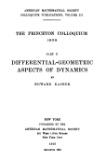| dc.contributor.author | Edward Kasner | |
| dc.date.accessioned | 2016-02-20T05:39:55Z | |
| dc.date.available | 2016-02-20T05:39:55Z | |
| dc.date.issued | 1913 | |
| dc.identifier.isbn | | |
| dc.identifier.issn | | |
| dc.identifier.uri | http://ir.nmu.org.ua/handle/GenofondUA/22549 | |
| dc.description.abstract | The relations between mathematics and physics have been
presented so frequently and so adequately in recent years, that
further discussion would seem unnecessary. Mathematics,
however, is too often taken to be analysis, and the role of geom-
etry is neglected. Geometry may be viewed either as a branch
of pure mathematics, or as the simplest of the physical sciences.
For our discussion we choose the latter point of view: geometry
is the science of actual physical or intuitive space. All physical
phenomena take place in space, and hence necessarily present
geometric aspects. We confine our discussion to mechanics,
and consider the r61e of geometry in mechanics. | |
| dc.language.iso | English | |
| dc.publisher | American Mathematical Society | |
| dc.subject | Математика\\Динамические системы | |
| dc.subject | Mathematics\\Dynamical Systems | |
| dc.subject.ddc | | |
| dc.subject.lcc | | |
| dc.title | Differential geometric aspects of dynamics | |
| dc.type | other | |
| dc.identifier.aich | FXOXMMFVMJFYWGWPKTLXVJHVPKOVD37I | |
| dc.identifier.crc32 | 65583B66 | |
| dc.identifier.doi | | |
| dc.identifier.edonkey | D59AAD97A41759DC083B86919367ACB4 | |
| dc.identifier.googlebookid | | |
| dc.identifier.openlibraryid | | |
| dc.identifier.udk | | |
| dc.identifier.bbk | | |
| dc.identifier.libgenid | 834751 | |
| dc.identifier.md5 | c1b167acf92a1f366e3a3a854a9f82f8 | |
| dc.identifier.sha1 | KCHQGDI2H7VCINYXADWJQUBLALP7F3CV | |
| dc.identifier.tth | VEFSXLXCQ4FMYXHD334IAXMV77MKNL6X5B3MIYQ | |

